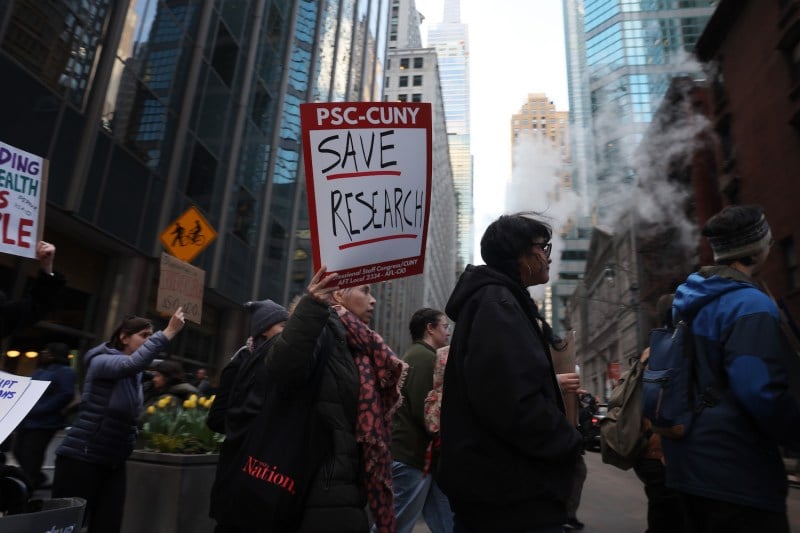Trump’s Shifting Tariffs Are Disrupting Global Shipping

Trump’s Shifting Tariffs Are Disrupting Global Shipping
Shipowners and sailors are recalculating routes daily.
A large container vessel operated by Danish shipping giant Maersk is docked at the Yantian International Container Terminal in Shenzhen, China, on April 12. Cheng Xin/Getty Images
“We’ll rant and we’ll roar like true British sailors,” goes the old sea shanty. It has been decades since the world’s oceans saw a lot of British sailors, let along ranting and roaring ones. The current situation off the U.S. West Coast, though, is causing plenty of suppressed ranting among seafarers and shipping lines. The United States may just have paused its 145 percent tariffs on China, but U.S. President Donald Trump’s trade war is still sending shockwaves across the oceans.
“You should be very optimistic and positive, because the president truthed it out, and I rely on the president,” U.S. Commerce Secretary Howard Lutnick told Fox News on May 11, after being asked about his response to warnings from union leaders that the impact of tariffs was “beginning to manifest itself as a real loss of jobs and income” for dockworkers.
“We’ll rant and we’ll roar like true British sailors,” goes the old sea shanty. It has been decades since the world’s oceans saw a lot of British sailors, let along ranting and roaring ones. The current situation off the U.S. West Coast, though, is causing plenty of suppressed ranting among seafarers and shipping lines. The United States may just have paused its 145 percent tariffs on China, but U.S. President Donald Trump’s trade war is still sending shockwaves across the oceans.
“You should be very optimistic and positive, because the president truthed it out, and I rely on the president,” U.S. Commerce Secretary Howard Lutnick told Fox News on May 11, after being asked about his response to warnings from union leaders that the impact of tariffs was “beginning to manifest itself as a real loss of jobs and income” for dockworkers.
The following day, the United States and China agreed to pause their sky-high tariffs of 145 percent and 125 percent, respectively. Now, for the next 90 days, the United States will impose 30 percent tariffs on goods coming from China, while China will impose 10 percent tariffs on U.S. goods—numbers that are still shockingly high compared with even three months ago. You should indeed be very optimistic and positive, because the president truthed it out.
But “you” is unlikely to include the global shipping industry. Shipping is, by definition, at the forefront of every change in global trading, so it has also been the first industry to feel the pain of Trump’s tariffs and the consequent escalating spiral. “The US accounts for almost 20% of containerised trade, primarily longhaul shipments from East Asia,” Ralph Leszczynski, the head of research at the maritime brokerage Banchero Costa, told news portal Riviera in early April.
U.S. imports from China suddenly became more than twice as expensive—which caused many Americans to cancel plans to buy Chinese-made goods and U.S. exporters to give up on even trying to find a market on the other side of the Pacific. The Port of Los Angeles, the United States’ busiest, forecast arrivals plummeting by one-third. When CNN checked arrivals at the Port of LA and the neighboring Port of Long Beach on May 9, the latter had seen arrival volumes plunge by 35-40 percent compared with normal volume, while arrivals at the Port of LA were down by 31 percent.
Cargo ship departures from China to the United States had nearly halved; as for LA and Long Beach, not a single ship was en route from China. “Realistically speaking, until some accord or framework can be reached with China, the volume coming out of there—save a couple of different commodities—will be very light at best,” Port of LA Executive Director Gene Seroka told CNBC in late April.
That was bad news for U.S. ports and their workers; indeed, the warning from dockworker representatives that the drop would cause layoffs was entirely unsurprising. Truckers were equally panicked, since their business often depends on port arrivals.
And it created instant chaos for shipowners and seafarers. The turbulence began the moment the tariffs were imposed on April 2. Because ships’ journeys from one side of the globe to the other take several days, Chinese-made cargo bound for the United States was en route but hadn’t yet arrived when Trump imposed the tariffs. That meant ships were carrying goods that, upon arrival, would cost more than twice as much as anticipated.
In China, exporters scrambled to find alternative buyers for their wares, and that primarily meant Europe or countries in Asia. But finding alternative buyers on short notice is hard work, and as Leszczynski pointed out to Riviera, “Even if East Asian exports shift to Europe or other Asian markets, it would still result in shorter distances for the average container, which means bad news for shipowners.”
Some U.S. importers deployed what Cindy Allen, the CEO of the customs brokerage Trade Force Multiplier, called the “hope and prayer strategy,” storing their imports at port facilities, since goods have technically not arrived in the country until released from the port. “You bring goods, you don’t pay the duty, you hope that it’s gonna go down—you hedge your bets,” Allen explained to Fortune. “I’ve heard companies say, ‘When I ordered this, the duty rate was 2.5% and now it’s 145%; I can’t afford that.’”
The hope and prayer strategy worked: 30 percent U.S. tariffs (and 10 percent Chinese tariffs) are definitely preferable to 145 percent and 125 percent. But 30 percent is still high—and nobody knows what will happen after the 90-day pause. “We have manufacturing clients adapting their supply chains similarly to how they did with the tariffs during Trump’s first administration—moving stuff away from China and into lower-tariffed countries for onward import to the U.S.,” said Cormac Mc Garry, the director of maritime intelligence and security services at the consultancy Control Risks. “The difference now is the acceptance, even with this recent reprieve, that Americans are just going to consume less, and the ship-booking data is irrefutable proof of that.”
Every decision and every verbal jousting match between Trump and foreign leaders will cause more turbulence in already deeply stormy waters. The Houthis have made the crucial Red Sea and the Suez Canal virtually impassable for Western shipping lines, and the shadow fleet operated by Russia has grown so quickly that it now poses a real hazard to legally sailing ships.
As is their wont, shipping lines have adapted their journeys and procedures. They’ve rerouted from Suez to the Cape of Good Hope, a much longer trip, and they’ve developed protocols to better detect shadow vessels whose manipulated identification systems may show them sailing somewhere completely different. And as Mc Garry noted, they’re steering away from China-U.S. routes.
In the short term, that means trouble for seafarers, whose planned voyages may not take place. “Some routes will change, but the reality for most crews is either a longer period of not being paid or having to find alternative employment,” said Simon Lockwood, the head of shipowners at the insurance broker WTW. “For seafarers, it’s hard to find alternative employment at short notice.” Since seafarers work on a contract basis, not as salaried employees, lost assignments equate lost income—and seafarers who didn’t lose routes found their assignments and schedules changed.
But seafarers, who are used to turbulence, look likely to bounce back. “There’s a crewing crisis, and demand is still greater than supply,” Lockwood said. The long-term harm caused by the shipping turbulence may instead hit land. “Shipping will be fine and is way ahead,” Mc Garry said. “Vessels have literally already been rerouted to maximize profit on more dependable routes. America’s ports and domestic businesses don’t have that luxury.”
The dockworker unions may be onto something with their warning of looming job losses. Even if U.S. tariffs on China don’t shoot up to 145 percent again, the shipping industry is likely to shift its focus to routes that don’t bring sudden, politically motivated turbulence. And if there are not enough ships and seafarers to bring goods to the United States, well, that’s an issue Lutnick may find himself addressing in future Fox appearances.
Elisabeth Braw is a columnist at Foreign Policy, a senior fellow at the Atlantic Council, and the author of “Goodbye Globalization.” X: @elisabethbraw
More from Foreign Policy
-

Indian Air Force personnel stand in front of a Rafale fighter jet during a military aviation exhibition at the Yelahanka Air Force Station in Bengaluru. A Tale of Four Fighter Jets
The aircraft India and Pakistan use to strike each other tell a story of key geopolitical shifts.
-

A cardinal in a black robe with red sash with hands folded in front of him walks past a stage and steps. Conclave Sends Message With American Pope
Some cardinals had been agitating for U.S. leadership to counter Trump.
-

An illustration shows red tape lines crossing over and entrapping a semiconductor chip. Is It Too Late to Slow China’s AI Development?
The U.S. has been trying to keep its technological lead through export restrictions, but China is closing the gap.
-

A man watches a news program about Chinese military drills surrounding Taiwan, on a giant screen outside a shopping mall in Beijing on Oct. 14, 2024. The Pentagon Fixates on War Over Taiwan
While U.S. military leaders fret about China, Trump has dismissed the Asia-Pacific.













Join the Conversation
Commenting on this and other recent articles is just one benefit of a Foreign Policy subscription.
Already a subscriber?
.
Subscribe
Subscribe
View Comments
Join the Conversation
Join the conversation on this and other recent Foreign Policy articles when you subscribe now.
Subscribe
Subscribe
Not your account?
View Comments
Join the Conversation
Please follow our comment guidelines, stay on topic, and be civil, courteous, and respectful of others’ beliefs.
Change your username |
Log out
Change your username:
CANCEL
Confirm your username to get started.
The default username below has been generated using the first name and last initial on your FP subscriber account. Usernames may be updated at any time and must not contain inappropriate or offensive language.